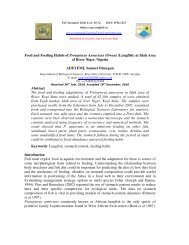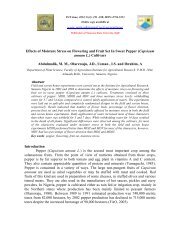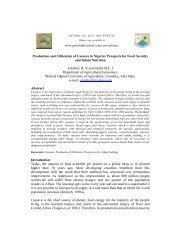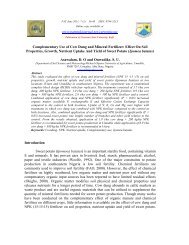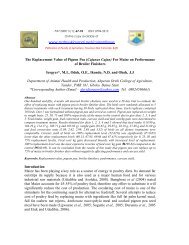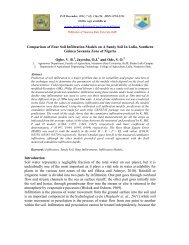Effects of Time and Method of Pig Manure Application on Growth ...
Effects of Time and Method of Pig Manure Application on Growth ...
Effects of Time and Method of Pig Manure Application on Growth ...
Create successful ePaper yourself
Turn your PDF publications into a flip-book with our unique Google optimized e-Paper software.
PAT 2011;7 (1): 103 -116 ISSN: 0794-5213; Iren et al.,, <str<strong>on</strong>g>Effects</str<strong>on</strong>g> <str<strong>on</strong>g>of</str<strong>on</strong>g> <str<strong>on</strong>g>Time</str<strong>on</strong>g> <str<strong>on</strong>g>and</str<strong>on</strong>g> <str<strong>on</strong>g>Method</str<strong>on</strong>g> <str<strong>on</strong>g>of</str<strong>on</strong>g> <str<strong>on</strong>g>Pig</str<strong>on</strong>g> <str<strong>on</strong>g>Manure</str<strong>on</strong>g> <str<strong>on</strong>g>Applicati<strong>on</strong></str<strong>on</strong>g> .. 106<br />
gives a plant populati<strong>on</strong> <str<strong>on</strong>g>of</str<strong>on</strong>g> 450 plants per bed (450/4.5 m 2 ) <str<strong>on</strong>g>and</str<strong>on</strong>g> 1,000,000 plants per<br />
hectare. The plots were kept weed free throughout the cropping period by h<str<strong>on</strong>g>and</str<strong>on</strong>g> pulling<br />
because <str<strong>on</strong>g>of</str<strong>on</strong>g> the closeness <str<strong>on</strong>g>of</str<strong>on</strong>g> the plants. Watering was d<strong>on</strong>e 2 times a day (morning <str<strong>on</strong>g>and</str<strong>on</strong>g><br />
evening) at the initial stage <str<strong>on</strong>g>of</str<strong>on</strong>g> development, <str<strong>on</strong>g>and</str<strong>on</strong>g> later reduced to <strong>on</strong>ce (evening <strong>on</strong>ly)<br />
every day, due to good canopy development that shaded the ground <str<strong>on</strong>g>and</str<strong>on</strong>g> reduced soil<br />
moisture loss.<br />
Ten plants in each plot were r<str<strong>on</strong>g>and</str<strong>on</strong>g>omly selected <str<strong>on</strong>g>and</str<strong>on</strong>g> tagged. From the tagged<br />
plant in each treatment plot, plant height, number <str<strong>on</strong>g>of</str<strong>on</strong>g> leaves per plant, fresh yield <str<strong>on</strong>g>and</str<strong>on</strong>g> dry<br />
matter yield were measured. Plant height was measured with a meter rule as the height<br />
from the base <str<strong>on</strong>g>of</str<strong>on</strong>g> the crop (ground level) to the tip <str<strong>on</strong>g>of</str<strong>on</strong>g> the plant, while the number <str<strong>on</strong>g>of</str<strong>on</strong>g><br />
leaves was taken to be the fully opened leaves per plant. These measurements<br />
commenced 3 weeks after planting <str<strong>on</strong>g>and</str<strong>on</strong>g> c<strong>on</strong>tinued at weekly interval until the end <str<strong>on</strong>g>of</str<strong>on</strong>g> the<br />
experiment. Harvesting was d<strong>on</strong>e at 5 weeks after planting (5 WAP) by uprooting the<br />
entire plant from an area <str<strong>on</strong>g>of</str<strong>on</strong>g> 100 cm x 100 cm at the centre <str<strong>on</strong>g>of</str<strong>on</strong>g> each plot. Fresh yield data<br />
was taken at the time <str<strong>on</strong>g>of</str<strong>on</strong>g> harvest, where the weight <str<strong>on</strong>g>of</str<strong>on</strong>g> the uprooted plants were<br />
determined plot by plot after rinsing the roots free <str<strong>on</strong>g>of</str<strong>on</strong>g> s<str<strong>on</strong>g>and</str<strong>on</strong>g>. For dry matter<br />
determinati<strong>on</strong>, the ten tagged plants from each treatment plot were uprooted, rinsed, <str<strong>on</strong>g>and</str<strong>on</strong>g><br />
oven-dried at 65 0 C to c<strong>on</strong>stant weight (Maerere et al., 2001) <str<strong>on</strong>g>and</str<strong>on</strong>g> the weight<br />
determined.<br />
The data were subjected to analysis <str<strong>on</strong>g>of</str<strong>on</strong>g> variance (ANOVA) using the general<br />
linear models (GLM) procedures <str<strong>on</strong>g>of</str<strong>on</strong>g> the Statistical Analysis Systems programme (SAS,<br />
1989) to determine treatment effects. Treatment means, where significant, were<br />
separated using Fisher’s Least Significant Difference (FLSD) at 0.05 probability level<br />
(Wahua, 1999).<br />
Results <str<strong>on</strong>g>and</str<strong>on</strong>g> discussi<strong>on</strong><br />
Effect <str<strong>on</strong>g>of</str<strong>on</strong>g> time <str<strong>on</strong>g>and</str<strong>on</strong>g> method <str<strong>on</strong>g>of</str<strong>on</strong>g> pig manure applicati<strong>on</strong> <strong>on</strong> Amaranthus height<br />
The time <str<strong>on</strong>g>of</str<strong>on</strong>g> manure applicati<strong>on</strong> independently affected Amaranthus height in<br />
both years (Table 1) with the <strong>on</strong>e week before planting (1WBP) time producing the<br />
tallest plant at all stages <str<strong>on</strong>g>of</str<strong>on</strong>g> measurements (3 WAP, 4 WAP, 5 WAP), followed by the at<br />
planting (AP) time <str<strong>on</strong>g>of</str<strong>on</strong>g> manure applicati<strong>on</strong>, while the shortest plant was obtained from<br />
the two weeks after planting (2 WAP) time <str<strong>on</strong>g>of</str<strong>on</strong>g> applicati<strong>on</strong>. From the overall effect <str<strong>on</strong>g>of</str<strong>on</strong>g><br />
time <str<strong>on</strong>g>of</str<strong>on</strong>g> manure applicati<strong>on</strong> <strong>on</strong> plant height in both years (Table 2), the highest plant<br />
height <str<strong>on</strong>g>of</str<strong>on</strong>g> 17.79 cm at the growth stage <str<strong>on</strong>g>of</str<strong>on</strong>g> 3 WAP was obtained from the 1 WBP time <str<strong>on</strong>g>of</str<strong>on</strong>g><br />
applicati<strong>on</strong> but it was not significantly different from the other times <str<strong>on</strong>g>of</str<strong>on</strong>g> applicati<strong>on</strong><br />
except the 2 WAP time <str<strong>on</strong>g>of</str<strong>on</strong>g> manure applicati<strong>on</strong> which had a mean height value <str<strong>on</strong>g>of</str<strong>on</strong>g> 14.10<br />
cm. At the growth stage <str<strong>on</strong>g>of</str<strong>on</strong>g> 4 WAP, the tallest plant <str<strong>on</strong>g>of</str<strong>on</strong>g> 37.79 cm obtained with the<br />
1WBP time <str<strong>on</strong>g>of</str<strong>on</strong>g> applicati<strong>on</strong> was significantly (P< 0.05) higher than the heights obtained<br />
from the other times <str<strong>on</strong>g>of</str<strong>on</strong>g> manure applicati<strong>on</strong> except the AP time <str<strong>on</strong>g>of</str<strong>on</strong>g> applicati<strong>on</strong>.The height



